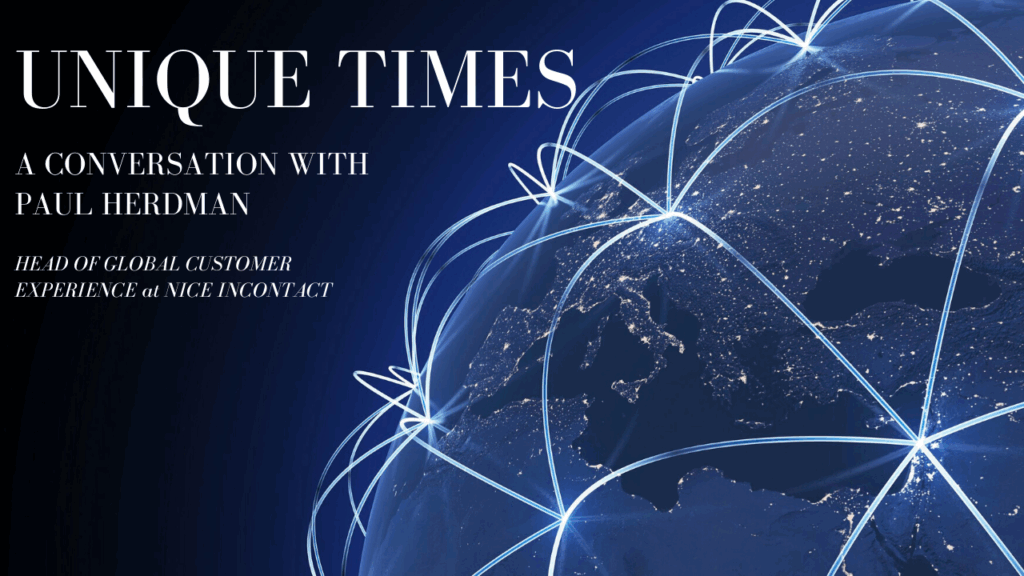Q: Can you talk a little bit about you and your role at Nice InContact?
A: Sure, I am the Global Head of Customer Experience at Nice InContact. I run the customer experience group, which is our traditional customer experience functions; so customer journey mapping, journey design, continuous improvement, metrics, measurement, those sorts of things.
Q: Can you talk about what your team has done in the wake of COVID19, how those early internal meetings went when you started to see what was going on, and some of the policies you have implemented within your contact centers?
A: Nice InContact as the Cloud Unit has about 1,700 or so employees in about 30 offices. From a support perspective, we run a global footprint so you can always call and get help from an engineer, get questions answered, and that runs on a continuous basis. Being a global company, this process puts us in an interesting position because we’re a provider but also a consumer of our own products and services. This process started in January, I was actually in the Philippines when the COVID issue hit in China, and the proximity was really close. The last ten days or so have really been the catalyst. We’ve had to virtualized as much as we can, we did a lot of prep and planning in the beginning. The advantage that we do have however is that we do use our own products and platforms. We already have a platform that will allow us to be virtual, we have an integrated phone to take calls, and pass traffic and data, so we used our own products and leveraged them to the fullest so we could continue to support customers when they need it most.
Q: What are some of the pain points from customers and have you seen a spike in call volume globally? Do certain channels take over?
A: There are two pieces of that for me. From an external perspective what we’re seeing with our customers is that there really is an unprecedented increase in volume. So their end customers calling our customers to get help.. as events get rescheduled and things get canceled, and going through any of those industries, whether its retail, healthcare, technology, something is happening in all of those industries that is driving just an inordinate amount of volume to our customers when then drives it back to us I regarding the technology.
Internally, and supporting our direct customers, there has been a 15-20% increase in volume from them needing help, needing advice—and I really think we’re going to see more than that in the next couple of weeks and we are prepared for that.
Q: What are some of the things that you have implemented in regards to “virtualizing” your workforce?
A: The integrated softphone that has been integrated over 10 years ago and has always been an option for those at-home agents—but especially now there has really been a rush to get that integrated softphone out there, to be able to take calls via the internet, have a phone on the screens with no need for a physical hard phone. If you call for help through our organization, we are using the exact same product with our own teams. There is another piece that was a bit unexpected, customers are calling with concerns about monitoring the productivity and motivation levels of their agents since now they can’t see them. But now we have customers adding workforce components whether it be workforce management, workforce intelligence inside the routing engines, quality management for increased QA—now that their folks aren’t there anymore, they really want to be able to ensure productivity. So those products, which have always been there, now have more and more customers that are reliant on them and want them to be easy because obviously, we’re all stretched to the max.
Q: Have you seen the difference between customers actually giving computers to their workforce versus having them use their at-home systems?
A: For sure. Some organizations are able to give out laptops, a lot of folks are giving out thin clients, which work perfectly well as long as you have an internet connection and the right tools. You can pretty much use most (“most” with an asterisk) devices or any device you happen to have as long as it meets the requirements. The most important thing is headsets. We made a joke that in the call center industry headsets are the new toilet paper!
Q: Do you think this situation changes how people think about cloud-based systems, or changes how you think about the type of products you plan on releasing in the future?
A: I think we will be different now because of this. This event in history is significant enough for a lot of reasons, there’s no way we can be the same. There was already a movement that was happening, but in these sorts of times, it really shines a bright spotlight on the fact that you need a plan B or even a plan C. I think from a product perspective, we as an organization have always been pushing towards AI and orchestration, and I think this even will only renew this focus. There is a big focus on human to human contact right now, and what a lot of customers are seeing is that there just aren’t enough humans- and that will really stoke the fire around AI, automation, and things like Robotic Process Automation (RPA).
Q: To get off the topic of coronavirus, what should we be looking at in terms of AI, and what will we expect to see with that technology a year from now?
A: AI is a great topic. Obviously, AI is a core component of where we are and where we’re going. Inside our existing product suite, we have AI implemented in a lot of places: chatbots, intelligent routing, and so it already exists today really well in point solutions. If you have a problem, there is probably a bot that can solve it for you today. Where we’re going with AI is more integrated, for example, Google dialog flows and the IBM Watsons, and those types of providers that allow you to be a multipoint solution. The next step is how we embed that multipoint AI across multiple functions, so not just the ability to have a chatbot, but how we have more complicated and back-force functions. We want to use AI not to eliminate agents, but to empower them.
Q: How far away is that?
A: I’d say in most cases, it’s measured in days, weeks, months, not years. A lot of this technology is here now.
Q: Do you see any other tools that are flying under the radar that interest you?
A: Yeah, RPA, or Robotic Process Automation, is something that’s a little off the radar with some of the smaller centers. But as this gets more sophisticated and integrated with the contact centers’ suite of technology, I think it’s definitely something that will be more reachable for the masses, which can really change the agent role and the experience that agents have. I’d also say the analytics piece is certainly something that’s becoming more and more prevalent.
Q: Where can our listeners find you to get in touch?
A: You can follow me on LinkedIn at Paul Herding. There actually is another Paul Herding in InContact, if you can imagine that. Obviously, you know, NiceInContact.com. We’ll get you all of the assets that you need to connect with anyone inside our organization. We are also right now going out to customers who are really struggling with their business continuity plans and helping them get to the Cloud in 48 or so hours. So certainly there’s more information about that on NiceInContact.com





